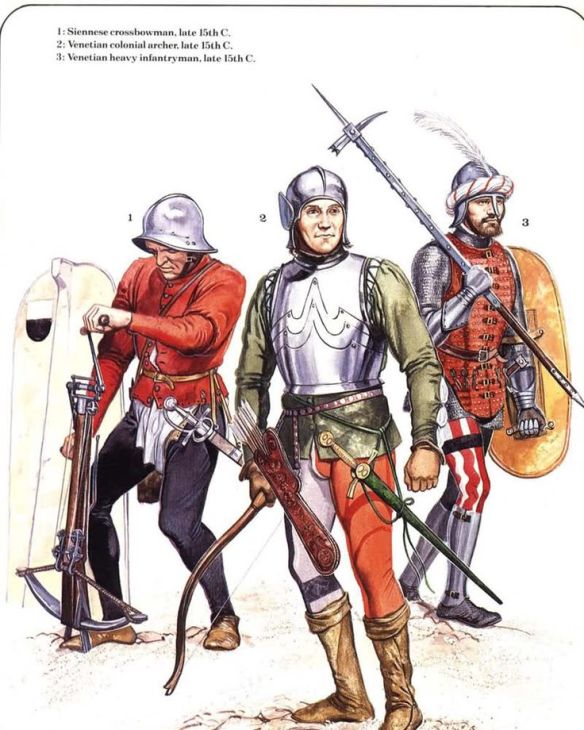The conduct of warfare for soldiers’ profit meant that plundering was common practice. In the wake of the Black Death (from 1348) and the huge expense of King John’s ransom (after 1356), the French peasantry suffered horribly. They rose in revolt (the Jacquerie) in 1358 but, after the 1360 treaty, unpaid mercenary bands ravaged uncontrollably for almost a decade.
The Sienese army sets out to defeat the freebooting Company del Capello at the battle of Sinalunga (1363) in this fresco by Lippo Vanni. It is a well-balanced force of men-at-arms, spearmen, and archers, with the infantry marching to music and the missilemen at least, under unit banners. The heraldry is that of the actual participants.
The danger of military history lies in presenting war in an acceptable form. It is not our intention to glorify war. However, much literature produced for medieval ruling elites did precisely that, in their celebration of martial values. It contains descriptions ranging from sober reportage to fictional deeds of arms. Medieval depictions of military scenes are important sources for arms, armour, and techniques, but the written sources are rarely first-hand, and the visual representations are not ‘photographic’. Some indication of the nature of combat is provided by the gruesome contents of three graves, containing 1,185 corpses from the battle of Wisby (1361), in Gotland, Sweden. The skeletons display the effects of crossbow bolts descending vertically, piercing mail coifs, sword and axe cuts, and blows from maces and morning-stars (spiked balls attached by a chain to a handle). In one case the lower legs were severed, and several skulls exhibited deep cuts. The lower legs below the protection of shields suffered many deep wounds. Many corpses were stripped, but some were buried with their armour, owing to advancing decomposition. The finds are in the National Museum of Antiquities in Stockholm, Sweden, and are analysed in B. Thordeman, Annour from the Battle of Wisby, 1361.
Losses in battle were perhaps twenty to fifty per cent higher on the losing side. The knights’ armour and ransom value meant that most of the dead were commoners, although the French nobility suffered heavily at Courtrai (1328) and Agincourt (1415). Commanders had to lead from the front, so death was always a risk. Harold’s death at Hastings (1066) made it a decisive victory for William. Nor was battle the only cause of death. Emperor Frederick I drowned in a river in 1190. Although Richard I survived a crossbow bolt in his knee in. 1196, in 1199 a similar wound in his shoulder, sustained during a siege, killed him. The barbed arrowhead had to be cut out with no anesthetic, and without antiseptic the wound became gangrenous. Surgery was primitive, as it would remain until the second half of the nineteenth century.
After the sixteenth century, records show how armies wasted away through disease and desertion (see Geoffrey Parker, The Military Revolution, pp.53-58), and. this must have been true earlier. Armies, with their attendant horses, produced sewage which bred dysentery when they were static, when mustering or during sieges. Professor Bachrach’s speculations concerning the by-products of the Norman army in 1066 illustrate the problem commanders faced, and frequently coped with successfully (Bachrach, ‘The Military Administration of the Norman Conquest’, Anglo-Norman Studies, pp.1-25). Of a list of ninety-eight dead on the Third Crusade, eighty-four apparently died through sickness. An eye-witness reported that ‘by famine and by malady more than 3,000 were struck down at the siege of Acre’ (cited by John Gillingham, Richard Coeur de Lion, p. 221). Henry V’s army lost at least fifteen per cent of its strength to dysentery at the siege of Harfleur, and more on the way to Agincourt. English casualties in the battle of Agincourt were about five per cent (Christopher Allmand, Henry V, p.211-12). Henry’s own death was caused by the unhealthy conditions of siege lines. Supply and disease were closely related, and most medieval commanders were well aware of the need to supply their armies in the field and to stock their fortresses in wartime.
Few sources dwell on ravaging, the central feature of medieval warfare. Bertrand de Born, a late twelfth-century chivalric writer, greeted the onset of the campaigning season: ‘I love the gay Eastertide, which brings forth leaves and flowers .. .it gives me great joy to see, drawn up on the field, knights and horses in battle array. And it delights me when the skirmishers scatter people and herds in their path:’ (from John Gillingham, Richard Coeur de Lion, p.243). What this entailed is described in a chanson de geste: ‘Out in front are the scouts and incendiaries. After them come the foragers …soon all is in tumult… the incendiaries set the villages on fire and the foragers visit and sack them. The terrified inhabitants are either burned or led away with their hands tied to be held for ransom…money, cattle, mules and sheep are all seized.’ (Gillingham, Richard Coeur de Lion, p.118). According to Orderic Vitalis, after William 1’s harrying of northern England in 1069-70, ‘so terrible a famine [fell] upon the humble and defenceless populace, that more than 100,000 Christian folk of both sexes, young and old alike, perished of hunger’. The figure simply means ‘a large number’. This was the deliberate creation of a zone of ‘scorched earth’, but an army a few thousand strong, with its horses and camp followers, was equal to a major town and was a severe drain on provisions. Armies and garrisons .could scour a region for supplies, and the result could easily be described as a ‘desert’. Even in friendly territory, armies often took what they wanted, including labour and carting services from the peasantry. However, war gradually ceased to be a slave-hunt, although this occurred at different rates. In eastern Europe, where scIavus (Slav) displaced the Latin servus as the word for a slave c.900, this development was slower than in the west.
